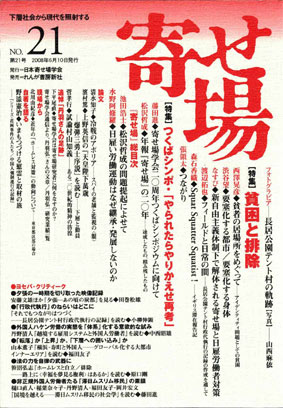|
|
|
|
|
|
|
|
|
日本寄せ場学会年報 No.13 No.14 発売元: |
『寄せ場』No.21(2008.6.)
フォトグラビア「長居公園テント村の軌跡」山西麻依 特集:貧困と排除 特集:つくばシンポ・「やられたらやりかえせ再考」 「冷戦のアポリア スパイの老舗と監視の〈眼〉」清水知子 追悼「丹羽さんの足跡」 現場から 自著を語る ヨセバ・クリティーク 学会日録 2007.5〜2008.4 Table of Contents Yoseba Annual 21 “If they get you, get them back!” - Rethinking an Old Slogan Photo-essay: Special Feature 1: Poverty and Exclusion <On the mass expulsion from Nagai Park, Osaka> Watanabe Takuji, 'Between the Field and the Everyday.' Special Feature 2: Proceedings of the 2007 Symposium at Tsukuba
University Papers Shimizu Tomoko, 'The Cold War Aporia: the Old School of Spies
and the “Eye” of Surveillance.' In Memoriam: 'The Footprints of Mister Niwa.' Thoughts of the Author: 'A Continuing Journey to Console the Spirits of the Dead and Document their Lives.' Nozoe Kenji discusses his book series, The People of the Hanaoka Incident: A Record of Chinese Forced Laborers. Book Reviews Higuchi, Inaba, Tanno et al., Kokkyo wo Koete (Crossing National
Borders). Reviewed by Fujita Susumu. A Report from the Field SUMMARIES OF PAPERS Shimizu Tomoko, 'The Cold War Aporia: the Old School of Spies and the “Eye” of Surveillance.' This paper seeks to investigate how the intelligence and information-gathering activities of Britain during the Cold War developed into the culture of surveillance and secrecy characteristic of Britain today, and to look at how that culture has permeated British people's everyday lives. It focuses firstly on the Anthony Blunt spy incident that came to light under the Thatcher regime, and also considers the numerous spy myths of that era, including the Cambridge Ring and the spy fiction of Ian Fleming and John Le Carrer. A powerful irony emerges from the analysis: that since the collapse of the Cold War order, and with the increasing spread of globalization, a new breed of spies has emerged, different from those of the Cold War era. They may be found, for example, in 'Neighbourhood Watch' associations: groups of citizens dedicated to maintaining 'safety' in the local community on the basis of excluding undesirable elements. It may not be going too far to see in these trends the advent of a society of internal spying in which anyone viewed as 'suspicious' is kept under constant surveillance. Thoughts of the Author: 'A Continuing Journey to Console the Spirits of the Dead and Document their Lives.' Nozue Kenji is a reportage writer who lives in the northern Japanese prefecture of Akita. On June 30, 1945, at the Kajima-gumi copper mine in Hanaoka, near Odate city in Akita prefecture, there was a mass uprising by 986 Chinese forced laborers against the brutal and abusive conditions imposed on them. The uprising was violently suppressed by the Kenpeitai and others. By the time the war ended and the workers could return to China, 418 had died. At the time, the author was attending an elementary school near Hanaoka, and he still recalls how he spat on the captured Chinese workers. After the war, he worked in mountain villages in the region before turning his hand to reportage. He has spent many years gathering testimony from people involved in the Hanaoka incident, starting with the difficult task of persuading Japanese involved in it to break their silence, and then making numerous journeys to China to interview survivors of Hanaoka. The fruits of his labors have been compiled in a four-volume series, Shiriizu: Hanaoka Jiken no Hitotachi - Chhgokujin Kyosei Renko no Kiroku (The People of the Hanaoka Incident: A Record of Chinese Forced Laborers), published by Shakai Hyoronsha. Today, Nozue is engaged in a project that will take him to all 135 of the sites in Japan where Chinese workers endured forced labor - a continuing journey to console the spirits of the dead and document their lives. Watanabe Takuya, 'Between the Field and the Everyday.' On February 6, 2007, the city of Osaka carried out a forced expulsion of homeless people living in tents in the city's Nagai Park. Eight months later, in October 2007, a record of the event, recording the experiences of 48 people involved in the expulsion, was published under the title Sore demo Tsunagari wa Tsuzuku: Nagai Koen Tento Mura Gyosei Daishikko no Kiroku (Even So, the Human Connections Continue: A Record of the Nagai Park Tent Village Expulsion). The author of this article was closely involved in the project as a member of the publication committee. Here he discusses how the idea of publishing the collection arose and describes the process leading to publication. Along the way, he reflects on how a researcher can go about closing the gap between his experience in the field and his everyday life. Moriishi Kaori, 'Squat, Squatter, Squatist! Report on a Stay in Britain.' The author spent three weeks in Britain in October 2007, visiting squats, infoshops, social centers, anarchist book fairs etc. Centers for information exchange and the activities of British NPOs appear to have developed on the basis of a European culture of public spiritedness. This paper also looks at the circumstances of British squatters, and their similarities and differences in comparison with those of homeless people in Japan. Nishizawa Akihiko, 'On the Whereabouts of the Poor: Poverty as an Identity Problem.' For members of the homeless class of today, finding friends who will tolerate each other's existence is a difficult challenge. Consequently the poverty-stricken individual comes to perceive himself simply as something to be rejected. One of the factors giving rise to that problem is the lack of a space in which to negotiate identities with friends. Unlike the underclass of yesteryear, who would gather in the yoseba day-laboring districts, the homeless class of today is spatially scattered but still controlled. Workers who register with temporary personnel dispatch agencies, laboring by the day at sites communicated to them via mobile telephone, are a classic example of the new, dispersed homeless class. |
